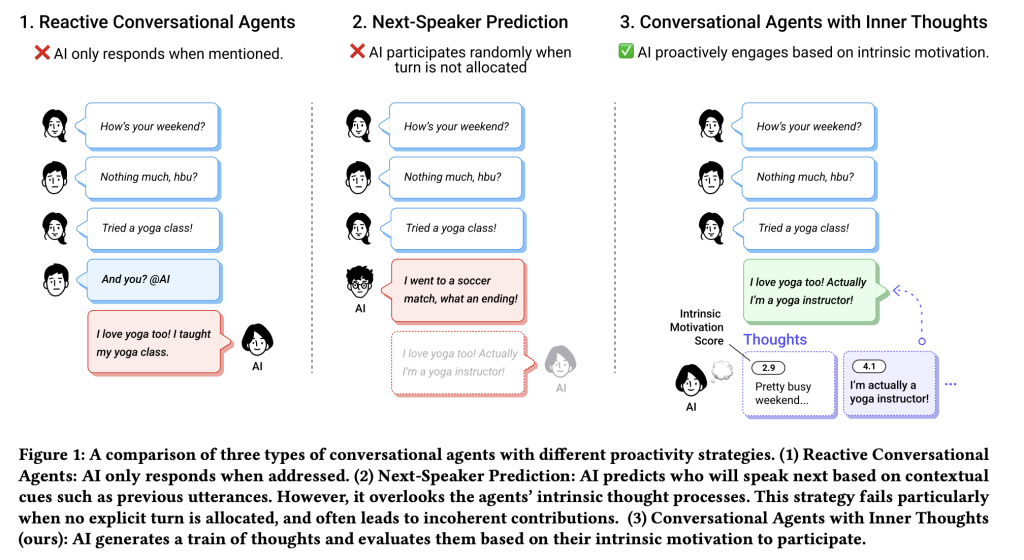

Conversational AI has come a long way, but one challenge persists: getting systems to engage proactively in a way that feels natural. Many AI tools either wait passively for direct prompts or overwhelm users by jumping into conversations unnecessarily. This is especially tricky in multi-party settings, where timing and relevance are everything. Striking the right balance is crucial—AI needs to contribute meaningfully without interrupting or taking over the discussion.
A team of researchers from Salesforce, The University of Tokyo, UCLA, and Northeastern University offers a fresh approach with the Inner Thoughts framework. This method gives AI an internal “train of thoughts,” allowing it to process the conversation quietly, decide whether it has something valuable to add, and find the right moment to contribute. Inspired by how people engage in dialogue, this framework helps AI systems feel more intuitive and context-aware.
The framework has been tested in two systems: a multi-agent simulation platform and a chatbot called Swimmy. Both demonstrated clear improvements in how well the AI participated in conversations, especially in maintaining coherence and timing.
Technical Details and Benefits
The Inner Thoughts framework consists of five main steps: Trigger, Retrieval, Thought Formation, Evaluation, and Participation. When something in the conversation happens, like a pause or a new message, the AI retrieves relevant memories, forms potential responses, and evaluates them. Only the most relevant and timely thoughts are shared, ensuring the AI’s contributions add value without disrupting the flow.

This framework uses both quick, instinctive responses and more thoughtful, deliberate contributions, mimicking the way humans switch between instinctive reactions and deeper reflections. This dual approach makes the system adaptable to different conversational styles.
Some key benefits include:
- Balanced Participation: AI contributes only when it’s meaningful and appropriate.
- Natural Flow: Contributions fit smoothly into the conversation.
- Positive Feedback: Users find the AI’s engagement more thoughtful and less intrusive.


Insights from Results
When tested against traditional models, the Inner Thoughts framework consistently performed better. Here are some highlights:
- Improved Metrics: The AI was rated higher for coherence, engagement, and adaptability.
- User Preference: More than 80% of participants preferred conversations with the Inner Thoughts AI.
- Better Timing: The AI’s ability to join conversations at the right moment was a standout feature.
For example, during a discussion about weekend plans, the AI chimed in about yoga when it recognized the relevance. This kind of thoughtful participation stood in stark contrast to older models, which often missed opportunities or responded out of context.

Conclusion
The Inner Thoughts framework marks an important step in making conversational AI more relatable and effective. By focusing on intrinsic motivations and carefully timed participation, it transforms AI from a reactive tool into an active, thoughtful participant. This approach opens up new possibilities for using AI in collaborative environments and social settings. As these systems continue to evolve, frameworks like Inner Thoughts offer a glimpse of how AI can seamlessly integrate into human conversations.
Check out the Paper. All credit for this research goes to the researchers of this project. Also, don’t forget to follow us on Twitter and join our Telegram Channel and LinkedIn Group. Don’t Forget to join our 60k+ ML SubReddit.
 FREE UPCOMING AI WEBINAR (JAN 15, 2025): Boost LLM Accuracy with Synthetic Data and Evaluation Intelligence–Join this webinar to gain actionable insights into boosting LLM model performance and accuracy while safeguarding data privacy.
FREE UPCOMING AI WEBINAR (JAN 15, 2025): Boost LLM Accuracy with Synthetic Data and Evaluation Intelligence–Join this webinar to gain actionable insights into boosting LLM model performance and accuracy while safeguarding data privacy.
The post Researchers from Salesforce, The University of Tokyo, UCLA, and Northeastern University Propose the Inner Thoughts Framework: A Novel Approach to Proactive AI in Multi-Party Conversations appeared first on MarkTechPost.
Source: Read MoreÂ



